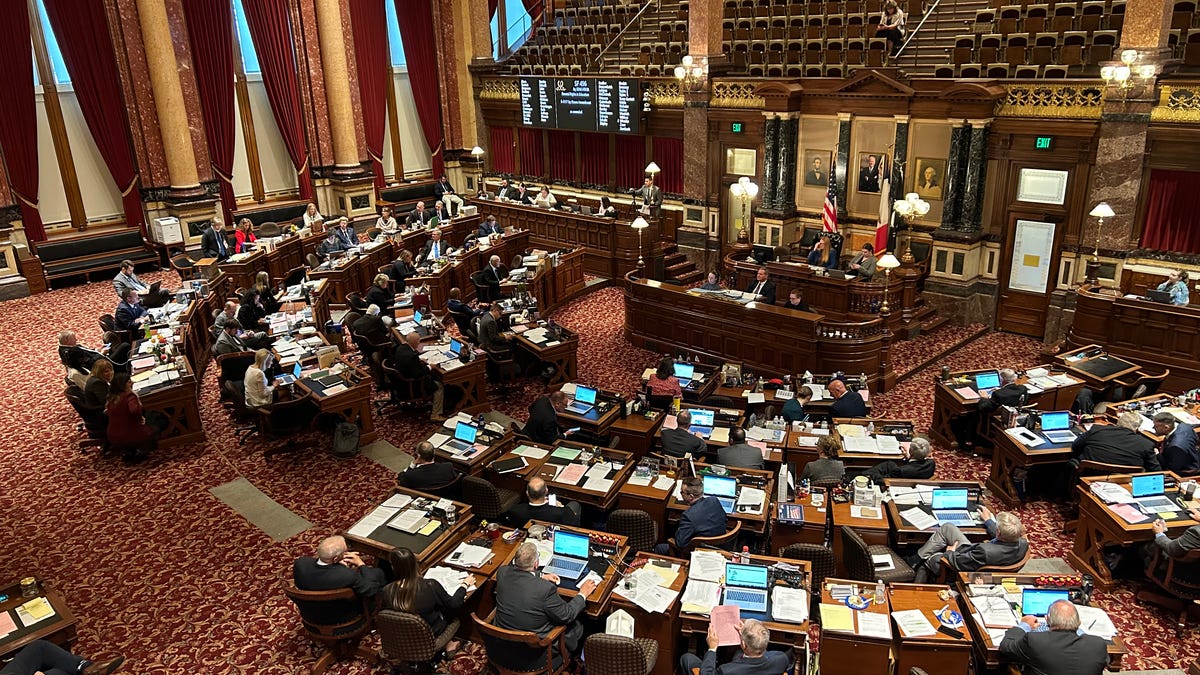North Dakota
Her dream house is sinking and deemed uninhabitable. Now she fears financial ruin.

WEST FARGO — Amanda DeLaPointe considered the house she bought charming. She liked the way it was set back in the yard, reminding her of a country cottage.
The house was surprisingly spacious, with ample room for a small dance studio, space for her to sew costumes, and lots of room for her young son.
“I thought it was cute,” she said. “I liked the neighborhood,” close to Meadowridge Park and a recreation trail. “It was just perfect for me.”
Extra touches included a deck with a small, enclosed gazebo. Although the house’s layout was a little odd, she considered the quirks endearing.
It was her first home purchase, and DeLaPointe, a single parent, prepared diligently. She took a first-time homebuyer’s class and hired an inspector to look the house over before she committed herself to the most important financial investment of her life.
Everything was as she’d hoped when she moved into the house in July 2017. Then one day a couple months later, in September, she noticed something alarming about her new home: cracks were forming in a wall.
DeLaPointe looked closer and saw that the ceiling and walls were coming apart. Not only that, she realized with alarm that the floor on the second level of the house was sinking.
“I was mortified,” she said.
The previous owner had disclosed some repairs to the foundation, but there were no signs of any problems when the home was inspected.
“It wasn’t a major concern,” she said.
After she discovered the cracks and learned the extent of the damage, it became clear more foundation repairs were needed, so DeLaPointe had the work done.
She assumed that the foundation repairs solved the problem. But it wasn’t long before the cracks began to reappear — and became progressively worse.
DeLaPointe watched in horror as her floor sank 2 inches within three weeks.
“It goes really fast,” she said. “When it goes really fast, it’s frightening. You can watch the cracks forming.”
In time, DeLaPointe discovered that she was facing a very major and very expensive problem. She came to a sobering understanding.
“I realized my house was sinking,” she said.
David Samson / The Forum
DeLaPointe has become accomplished in home repairs. She used a jackhammer to break up her cracking concrete floor and hauled 1,600 pounds of concrete fragments out of her house.
She learned to hang drywall and became adept at painting. She has repeatedly had to make repairs, redoing some rooms as many as three times in five years.
Her house kept moving, the walls and floors kept cracking, and she kept repairing.
“I’ve learned a lot,” DeLaPointe said. “I can patch drywall with the best of them. I’m a heck of a painter.”
She had hoped that her repair work would fix the problem.
“And it did for a while,” she said. “The whole time, though, I felt there was impending doom. It was always on my mind.”
For a few years, despite having to repeatedly make cosmetic repairs, it seemed as though the house had settled and her problem had gone away. Then, in 2021, the cracking rapidly grew worse.
DeLaPointe contacted the company that the previous owner had hired to shore up the foundation, installing a steel beam with three wall anchors in the basement in 2016.
Eager for a solution, she borrowed money from a friend to pay a company to install supports called piers. The project involved removing all the flooring on two levels to dig deep trenches in the basement.
During the construction, DeLaPointe and her son had to live in a motel for a week while the work was done.
It eventually became obvious that the project, as extensive as it was, hadn’t solved the problem. The work focused on the perimeter of the foundation. A more thorough solution would require removing the entire foundation — at an estimated cost of more than $100,000.
That was more than DeLaPointe, who works as an office administrator at a local university, could afford. Also, given her experience, she wasn’t convinced such extensive remediation would end her problems.
She contacted a real estate agent to see if she could sell the house. After looking at her house, the Realtor started crying.
“She said, ‘I don’t know how to help you.’ ”
DeLaPointe was becoming desperate. She accepted that, with such serious structural problems remaining after she’d spent thousands of dollars, she couldn’t in good conscience sell her money pit.
But what could she do with a sinking house? Her dream home had become a nightmare.

David Samson / The Forum
A question nagged at DeLaPointe as she groped for a way out of her dilemma: How had her house been built on top of such unstable soils?
Her quest for a fix for her sinking house led her to consult with geologists and geotechnical consultants.
From the North Dakota Geological Survey, she learned that a report released in 1974 to aid land-use planners in Cass County flagged certain areas where unstable soils containing deposits from ancient Lake Agassiz were unsuitable for building.
“These areas have generally low-bearing strength, high water content, high liquid limit, and high plasticity index,” the report said, with maps and descriptions of the problem areas. “These areas pose particular problems because the water in the buried saturated sand is under considerable pressure in many areas. The result is quick conditions are commonly encountered, especially in the western part of Fargo.”
DeLaPointe’s house, at 2120 4th Ave. E. in West Fargo, is just a few blocks from Fargo — and not far from the site
where a grain elevator along Main Avenue in Fargo collapsed in 1955,
which the report noted.
The houses in West Fargo’s Meadowridge subdivision were mainly built in the 1970s; DeLaPointe’s house was built in 1980.
On a map in the 1974 report for land-use planners, DeLaPointe is able to find the location of her house — atop a buried sand channel identified as one of the areas with low load-bearing capacity.
Did city engineers and planners know about the problem areas, DeLaPointe wondered, and if they didn’t, shouldn’t they have known?
The report, and others like it, is made available to engineers, planners and others, said Fred Anderson, a geologist with the North Dakota Geological Survey who is familiar with the unstable soils beneath DeLaPointe’s house.
The Geological Survey has a page with links to maps with information about the geology in areas of the state, including the Fargo area.
“Now, whether they would adhere to that information is another item,” Anderson said. “Certainly the information has been there for public awareness and the planning and engineering community.”
In October 2022, DeLaPointe contacted City Engineer Ben Hanson and asked for help in locating a “Resource for viewing geotechnical/soil suitability reports submitted for the approval of the Meadowridge subdivision in the late 1970s.”
Hanson replied that he was unable to locate the documents.
“At the time this home was built the City of West Fargo did not have an engineering department or any engineering staff,” Rachel Richter Lordemann, the city’s communications manager, said in an email. “Development was done by a consulting engineer. We do not have records of what reports those consulting engineers would have used at the time of construction of these homes.”
The records of that period fall “well outside the time frame of any records retention policy and it is likely those records are no longer on file,” Richter Lordemann added.
Although it is difficult to speculate, she said, “any geotechnical report that would have been used for the development would’ve focused on construction of streets and utilities and would not have had any analysis on home construction means or methods.”
Some of DeLaPointe’s neighbors are having similar problems with their foundations, although not as advanced or severe, she said.
Donald Schwert, a retired geology professor at North Dakota State University, extensively studied the geology underlying Fargo-Moorhead and the problems associated with sometimes unstable soil layers left behind by glacial Lake Agassiz.
“She’s not alone in having structural issues in that neighborhood,” he said, adding that he hasn’t investigated the problems but has heard of them. “There’s no insurance coverage available for this sort of problem; it’s beyond ordinary homeowners insurance coverage.”
DeLaPointe is disappointed in the city’s response to her problems over the years, which she said has ranged from unhelpful to rude at times.
The City of West Fargo isn’t in a position to provide any assistance for DeLaPointe, Richter Lordemann said, adding that “this is a matter of a private home and private property, and there is not a solution the City can provide on foundation repair.”

David Samson / The Forum
The never-ending problem of walls cracking and shifting became so severe in November of 2022 that DeLaPointe didn’t feel safe in her house, so she moved out.
Unable to pay both rent and her house payment, she went into default on her mortgage and is going through foreclosure.
She still owes about $160,000 on the $170,000 mortgage she took out to buy the house. After repeated requests, a city building inspector determined in January that the house is uninhabitable.
“This isn’t something I just let happen to me,” DeLaPointe said. “I have done everything I can to try to mitigate this,” including the inspection before she bought the house.
“I did all the right steps,” she said.
Her obligations as a homeowner haven’t gone away, however. She continues to pay city utilities, mow the lawn and clear the sidewalk in winter.
Because the cost of repairs is more than half of her home’s value, the house could be declared a dangerous building. The city’s emergency manager asked DeLaPointe if the city could burn it down for a training exercise for firefighters — a request she finds galling in light of what she considers the city’s lack of helpfulness.
Still, having the city torch the house might be cheaper than having to pay for demolition.
DeLaPointe fears she might be forced into bankruptcy, and her credit rating could be ruined for seven to 10 years.
“I’ve lost everything and need to start over,” she said. “I’m just trying to do the best that I can.”

North Dakota
Gambling at the double feature in 1913

The criminal court case earned the name the “bank night” case in the newspapers of the day, even if the charges had nothing to do with any banks or financial institutions.
The State Theater in Jamestown was accused of conducting a bank night which was against North Dakota’s lottery laws back in 1913.
Bank nights were common theater promotions back in that era. A drawing would be held and cash prizes awarded, hence the name bank night.
The Stutsman County state’s attorney interpreted this as an illegal lottery. Roy Metcalfe, State Theater manager, was arrested, tried and convicted on the lottery charge. Judge R.G. McFarland sentenced Metcalfe to 90 days in jail and a fine of $250.
The conviction was appealed by Metcalfe’s attorney to the North Dakota Supreme Court. North Dakota Gov. William Langer also filed papers in support of Metcalfe with the court, which ultimately denied the appeal.
About a week after the appeal was denied, Judge McFarland suspended the jail sentence and any remaining fines ending the case.
Long and short of the case, yes, it was illegal to hold a bank night at a theater in North Dakota in 1913, but the crime wasn’t worth locking the perpetrator away for three months.
Lotteries and raffles continued to be illegal in North Dakota for another six decades. The first change to those laws came in 1975 with an amendment to the North Dakota Constitution allowing some forms of charitable gaming and raffles.
Since then, other forms of gambling have been legalized in the state with full casinos limited to Native American reservations.
No word on whether any movie theaters are planning on resurrecting bank night.
Author Keith Norman can be reached at
www.KeithNormanBooks.com
North Dakota
North Dakota State transfer wide receiver Eli Green commits to Iowa State football

Iowa State coach Matt Campbell press conference at Tailgate Tour
Iowa State football coach Matt Campbell speaks with reporters at Cyclone Tailgate Tour
The Iowa State football program added a new pass-catcher to its ranks Friday.
Former North Dakota State wide receiver Eli Green announced his commitment to the Cyclones on Twitter. Green has played in 27 games at the FCS level with a powerhouse Bison program. During those games, he hauled in 51 receptions for 969 yards and four scores. He can also be a rushing threat, having run 14 times in his career for 128 yards, good for 9.1 yards per carry.
The vast majority of his production came as a sophomore, catching 45 passes for 877 yards and three scores. He led the Bison with 1,197 all-purpose yards, including 118 on the ground and another 202 as a kick returner.
Green will join a Cyclones wide receiver unit led by seniors Jaylin Noel and Jayden Higgins. That duo combined for 119 receptions for 1,803 yards and 13 touchdowns in 2023. The Cyclones’ offense also boasts talented young running back Abu Sama III and quarterback Rocco Becht looking to improve on an impressive freshman campaign.
North Dakota
North Dakota Council on the Arts launches Arts Across the Prairie

GRAND FORKS, N.D. (KFYR) – The North Dakota Council on the Arts is launching Arts Across the Prairie. It’s a first-of-its-kind, statewide, public art program showcasing the cultural heritage of eight regions.
The council hopes to break ground on the Grand Forks installation later this summer.
Copyright 2024 KFYR. All rights reserved.
-

 Politics1 week ago
Politics1 week agoThe White House has a new curator. Donna Hayashi Smith is the first Asian American to hold the post
-

 News1 week ago
News1 week agoPolice enter UCLA anti-war encampment; Arizona repeals Civil War-era abortion ban
-

 Politics1 week ago
Politics1 week agoAdams, NYPD cite 'global' effort to 'radicalize young people' after 300 arrested at Columbia, CUNY
-

 World1 week ago
World1 week agoTurkish police arrest hundreds at Istanbul May Day protests
-
)
) Movie Reviews1 week ago
Movie Reviews1 week agoThe Idea of You Movie Review: Anne Hathaway’s honest performance makes the film stand out in a not so formulaic rom-com
-

 News1 week ago
News1 week agoSome Republicans expected to join Arizona Democrats to pass repeal of 1864 abortion ban
-

 News1 week ago
News1 week agoSome Florida boaters seen on video dumping trash into ocean have been identified, officials say
-

 World1 week ago
World1 week agoIn the upcoming European elections, peace and security matter the most



















